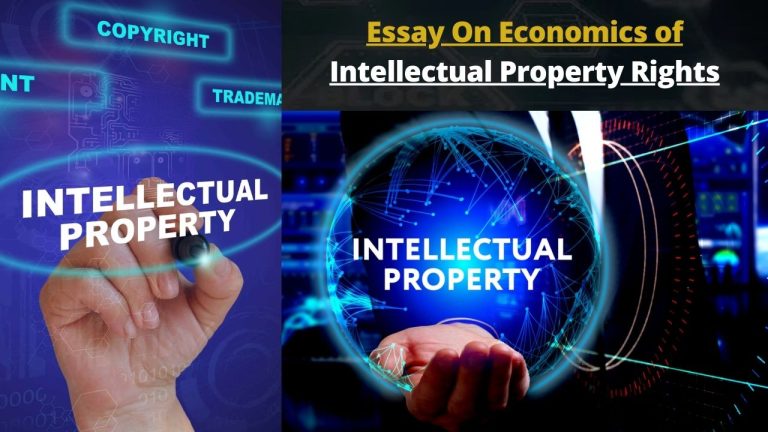"Advertisement"
Essay On Economics of Intellectual Property Rights
Hello My Dear Friend, In this post “Essay On Economics of Intellectual Property Rights“, We will be going to read about the Economics of Intellectual Property Rights as an Essay in detail. So…
Let’s Start…
Essay On Economics of Intellectual Property Rights
Introduction
Intellectual property rights (IPRs) shape innovation, creativity, and technical progress in the global economy.
The purpose of this essay is to investigate the economics of intellectual property rights, namely their impact on diverse stakeholders, the incentives they give, and the challenges they pose in a quickly expanding digital age.
1. Definition and Types of Intellectual Property Rights
Understanding the definition and many forms of intellectual property rights is critical for understanding the economics of intellectual property rights.
Patents, copyrights, trademarks, and trade secrets are examples of intangible assets that are the outcome of human knowledge.
Patents secure inventions and technological developments, copyrights protect creative and literary works, trademarks safeguard branding and commercial identities, and trade secrets safeguard sensitive information important to corporate competitiveness.
2. Incentives for Innovation and Creativity
The major economic reason for intellectual property rights is the incentives for innovation and creativity they provide.
IPRs encourage investment in research and development by granting exclusive rights to creators and innovators, encouraging a competitive market environment.
This type of protection enables innovators to monetize their ideas, rewarding their efforts and promoting future inventions.
Furthermore, IPRs allow businesses to ensure returns on investment, attracting capital and supporting economic progress.
3. Economic Impact on Stakeholders
Intellectual property rights affect a wide range of stakeholders, including artists, customers, and society as a whole.
IPRs provide an opportunity for creators to recoup investments, collect royalties, and develop reputations.
These incentives encourage creators to push boundaries and come up with fresh concepts.
However, detractors contend that overprotection can restrict competition, stifle creativity, and limit access to knowledge and information, particularly in fields like healthcare and education.
IPRs can result in higher costs and fewer alternatives for customers, particularly in industries dominated by monopolies or oligopolies.
This creates a delicate balance between encouraging innovation and maintaining access to basic goods and services. Policymakers must devise balanced policies that support innovation while protecting consumer welfare.
4. Challenges in the Digital Age
The intellectual property faces new hurdles in the digital age. The ease with which digital content may be copied and distributed has resulted in widespread piracy and unauthorized use.
This jeopardizes the economic viability of artists and complicates the enforcement of intellectual property rights. In an interconnected world, striking the correct balance between knowledge protection and sharing is critical.
Furthermore, emerging technologies such as blockchain and artificial intelligence are altering the intellectual property landscape.
While blockchain provides transparent and secure methods of recording and confirming ownership, AI raises concerns about authorship and ownership of generated content.
Policymakers and business stakeholders must respond to technology breakthroughs by developing frameworks that protect the rights of all parties involved.
Conclusion
Intellectual property economics emphasizes the importance of intellectual property rights in promoting innovation, creativity, and economic progress.
While intellectual property rights (IPRs) provide incentives for producers and inventors, they must be properly balanced in order to secure consumer access to important goods and services.
The digital age’s difficulties need proactive steps to protect intellectual property while also nurturing a robust and inclusive innovation ecosystem.
Intellectual property rights may continue to fuel economic progress while protecting the interests of creators, consumers, and society as a whole if the right balance is struck.
Finally, Thanks For Reading “Essay On Economics of Intellectual Property Rights“.
If you have any questions related to “Essay On Economics of Intellectual Property Rights“, So, please comment below.
Must Read:
Essay On Economics and laws relating to Artificial Intelligence
Essay On Economic and Legal Impact of Work from Home (WFH) Policy
"Advertisement"
